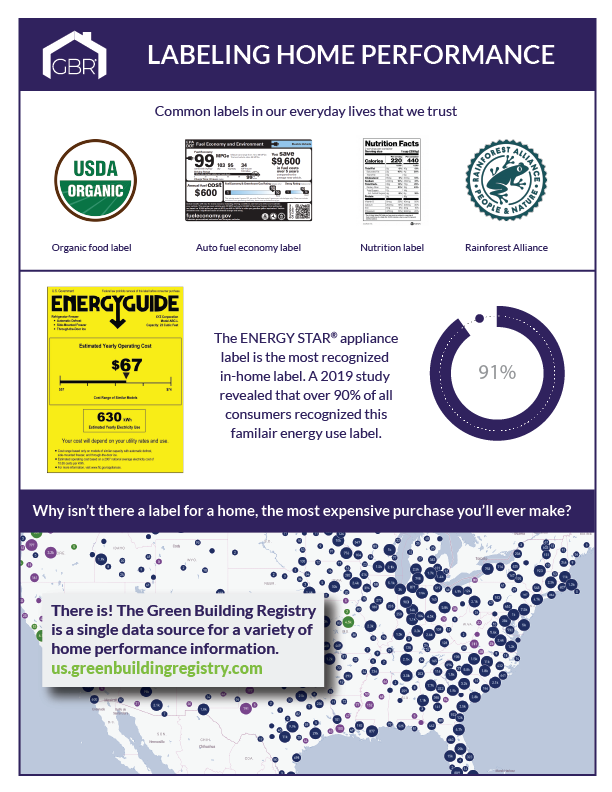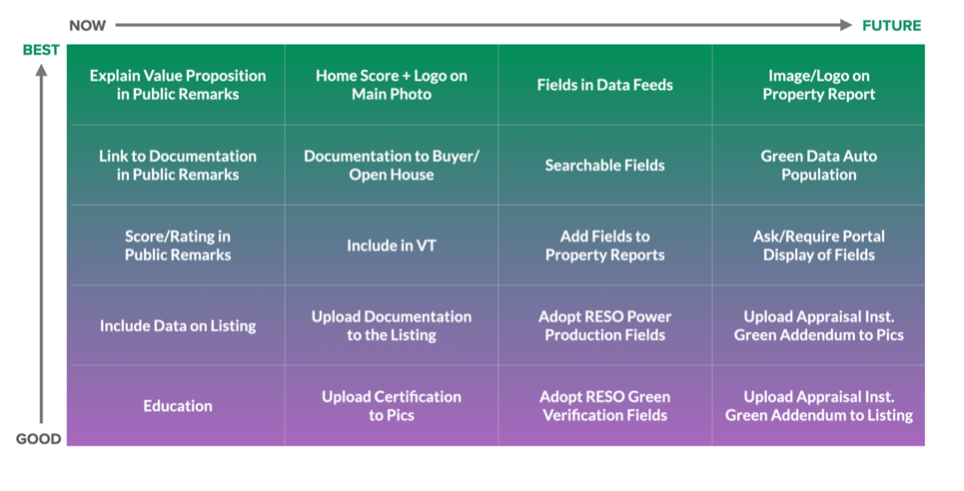Setting the Stage
Selling homes is all about showing the value of the home to potential buyers. That new modern kitchen? It’s fairly easy for buyers to see, real estate brokers to sell, and appraisers to value. Conversely, it is difficult to appreciate what you cannot see. It is even harder to put a monetary value on it. Yet the features that make a home more energy efficient are hidden behind walls, in the attic, and within the efficiency of the heating and cooling equipment, appliances, windows, and doors. That is why real estate agents and consumers should do a “green check” on every home they list or sell — to find any and all available information about a home’s energy features and performance.
Green Building Registry
The Green Building Registry (GBR) makes it easy for real estate professionals to conduct a one stop green check. Now with more than 1.7 million homes, GBR has grown into the largest single source of building certification information — including some data on rooftop solar — covering most major markets in the U.S. It contains most of the energy ratings or green certifications that a home may have. It’s a helpful tool for real estate professionals, whether a selling agent, a buying agent, or an appraiser. While the GBR supports several national, state and municipal energy labeling initiatives, the team at Earth Advantage continues to work on expanding the available data in GBR.

The GBR includes homes that have at least one building certification or rating in which a trained, independent, third-party professional has inspected the home and collected the data necessary to create a home energy report and energy label for each particular program. The certification and rating programs in the GBR include:
- Built Green
- Earth Advantage Home Certification (Zero and Zero Ready)
- EarthCraft
- ENERGY STAR®
- GreenPoint Rated
- HERS® Index Score
- Home Energy Score
- LEED for Homes
- National Green Building Standard
Now real estate brokers and homebuyers can easily do a green check! Anyone can search the free GBR website at us.greenbuildingregistry.com to see if a specific home has an energy label or to see how many homes in a defined area have energy labels. This is a great way for real estate brokers and appraisers to find comparable sales.
GBR is also set up to make electronic connections to local Multiple Listing Service (MLS) systems to automatically enter this energy information into listings. Soon more and more local MLS services will include the GBR data.
GBR supports three evolving trends in the real estate marketplace: energy labels, local energy disclosure policies and consumer-driven market considerations.
Energy Labels
Energy labels for homes are valuable because they estimate a home’s energy usage compared to other homes based on a home energy analysis. They make the real estate transaction more transparent, and make it easier to see, sell, and value those hidden energy features and benefits. Home energy labels address a consistent market failure: Homebuyers and real estate professionals don’t have access to verified information about the expected energy performance of a home. Not all homes are created equal, and often the only way to tell the difference between two seemingly comparable homes is with an energy label. This information helps a buyer make a more informed decision. Knowing a home’s estimated energy costs can help a buyer easily compare various homes, take their financial circumstances into account, and weigh home buying options.

To understand the value of the sustainable, renewable, and energy efficiency assets of a home, a homebuyer needs trustworthy data at the time of sale. As more homes receive home energy audits, have rooftop solar and batteries installed, and receive third-party home certifications (energy labels), it is critical that information is accurately displayed in a real estate listing.
Residential Energy Disclosure Policies
Because buildings account for 40% of U.S. energy use and about one-third of greenhouse gas emissions, there is an increased focus on ways to reduce energy use and lower emissions in our building stock. One way this is being accomplished is through energy labeling policies.
A growing number of states and municipalities are adopting mandatory energy labeling policies and programs to help accomplish their carbon reduction goals. This also helps increase homeowner awareness about their home’s efficiency, and often drives improvements prior to listing as has been seen with the City of Austin’s energy labeling ordinance that has been in place since 2009.
The City of Minneapolis has a Truth in Sale of Housing (TISH) policy that includes home energy labels, which started in 2020. The City of Portland, OR implemented a mandatory Home Energy Score Ordinance in 2017 to improve “the health, comfort, affordability and safety of Portland homes, while reducing carbon emissions necessary to meet their collective climate action goals.”
Many feel these labeling policies are a step forward for consumer protection and a way to provide more information to a potential buyer than what is available during a regular home inspection. An energy labeling policy also collects valuable market data, which is critical for the real estate industry.
Real Estate Market Considerations
When this information is included in a real estate listing, it allows the market to take energy efficiency into account at the time of sale. Otherwise, thousands of dollars of value could be lost because trustworthy data on energy costs was not available for a listing agent to set a fair price and for potential buyers to consider when making an offer.
The lack of energy data making it into listings also prevents appraisers from accounting for those market reactions to establish value and and lending institutions from issuing green mortgages.
The documentation that supports a home with an energy label could also provide a buyer more buying power using the energy cost estimate comparisons and including this data on the Appraisal Institute’s Residential Green & Energy Efficiency Addendum. Documentation helps alleviate greenwashing. Documentation helps alleviate inaccurate information, and helps build trust.
Real estate professionals are becoming more aware of the tools at their disposal to communicate energy and environmental attributes. More often than not, local Multiple Listing Services (MLSs) have included data fields that support energy labeling information. Real estate agents can be advocates to improve these systems by requesting the MLS adopt Real Estate Standards Organization fields for Green Verification and Power Production if they are not already part of their local MLS database.
Best Selling Practices
When it comes to using energy labels in the home sale process, the following are best practices for selling agents:
- Do your green check and enter this information on your listings.
- Tell the story about the features of the home in the public remarks.
- Download the available documentation and include it in your listing if MLS rules permit.
- Add the documentation as a photo or upload as a public attachment or document.
- Put this information out at open houses.
- Include in social media marketing for the home.
- Make sure to provide this information to a potential buyer and the appraiser.
This Marketing Matrix provides a variety of options that can be utilized to promote energy labels in listings:

The real estate sales sector requires accurate information. The Green Building Registry supports energy labelling, disclosure and marketing efforts that bring accurate, verified information to the market. Only when all homes disclose energy performance can the market function properly for all players.
Meg Garabrant is Sr. Manager Real Estate Services, Green Building Registry.

